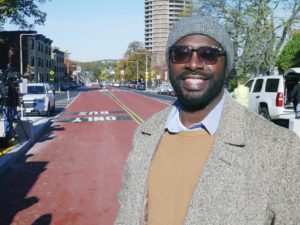When city and state officials gathered at the corner of Columbus and Walnut Avenues in October to mark the opening of the city’s first center-running bus lane, notably absent was representation from the Garrison Trotter Neighborhood Association, the resident group that claims many of the streets around the new lane.
“It’s a terrible design,” said the organization’s president, Louis Elisa, who lives on Seaver Street, half a block away from where the bus lane begins at Walnut Avenue. “It’s dangerous. It restricts and prohibits the flow of traffic.”
While the design has elicited negative reviews from some local homeowners and drivers, transit advocates and elected officials are bullish on extending the protected bus lane, which excludes car traffic and reduces the time buses take traveling to and from the Ruggles Orange Line station.
U.S. Representatives Ayanna Pressley and Stephen Lynch have secured $15 million in federal funding toward a similar project nearby, building out center bus lanes and protected bike lanes on the 2.6-mile stretch of Blue Hill Avenue between Mattapan Square and Grove Hall.
That proposal, like the Columbus Avenue bus lane, has generated some resistance.
“Some people love it, but it’s a love-or-hate thing,” notes Fatima Ali-Salaam, president of the Greater Mattapan Neighborhood Council. “But people recognize that something has to change. Every day, bus routes coming out of Mattapan station are overcrowded and late.”
As the number of cars registered in the Greater Boston area has risen in recent years and the city’s overall population has gone up by nearly 60,000 people in the last decade, Boston’s traffic has become among the second worst in the country, behind that of New York.
Between 2014 and 2019, more than 300,000 new vehicles were registered in the Greater Boston area, according to a 2019 analysis of census data by the Boston Globe.

Transit Matters Executive Director Jarred Johnson views the new center bus lane on Columbus Avenue at the intersection with
Walnut Avenue. BANNER PHOTO
Ali-Salaam says regional traffic patterns have a tight grip on Blue Hill Avenue, with most of the traffic on the thoroughfare originating in south-of-Boston towns such as Milton, Randolph, Stoughton and Brockton.
At the same time, Mattapan residents, who despite having relatively high homeownership rates have a median income of just $44,000, are heavily public transit-dependent.
“In Mattapan and Greater Mattapan, we are heavily dependent on buses,” she said.
The center bus lane proposed for Mattapan would reduce the number of travel lanes open to passenger cars and trucks, with traffic on the thoroughfare down to one lane in some areas to accommodate protected bicycle lanes. Although a 2021 City of Boston survey found that just 4.4% of commuters currently rely on bicycles to get to work, nearly twice as many respondents – 8% – said they planned to bike to work when they return to the office post-pandemic.
Jarred Johnson, executive director of the transit advocacy group TransitMatters, said the city’s plans to reduce auto traffic on major thoroughfares makes sense, given the ever-increasing number of cars in the city.
“Most folks look at our city and say we have too many cars as it is,” he said. “The city is choking on traffic. Another problem with incentivizing new cars is that it raises rates of asthma and other respiratory ailments.”
Johnson said that restricting auto traffic should happen in concert with improvements to public transit, such as reserved bus lanes. Those planned on Blue Hill Avenue could greatly reduce travel times between Mattapan and Ruggles stations.
Johnson’s group advocates upgrading the MBTA’s commuter rail network with modern rolling stock that would enable the agency to run trains faster and more frequently, bringing rapid transit to the underutilized rail network.
Providing more frequent service to cities and towns outside of Boston, such as Brockton, Worcester and Lowell, would go a long way toward reducing auto traffic on Blue Hill Avenue and other Boston thoroughfares, Johnson said.
Ali-Salaam said that without public transit improvements, traffic in Mattapan will only get worse.
“It can take you an hour to drive from Mattapan to Government Center,” she said. “It’s not sustainable. Our streets are not designed for the amount of traffic we have.”
Timeline and cost
City officials requested $25 million for the Blue Hill Avenue project from U.S. Department of Transportation’s RAISE (Rebuilding American Infrastructure with Sustainability and Equity) funding program and estimated its total cost would be $39.5 million. In a statement sent to the Banner, a Mayor’s Press Office spokesperson said the city and MBTA would seek additional sources of federal funding.
City and state officials are currently in the process of hiring community outreach consultants to seek input from neighborhood groups on the design of the project.
“We will be spending the next 18 months conducting an extensive community process with local groups and bus riders to develop concept and final designs for the bus lanes, pedestrian safety measures, and the accommodation of bike facilities,” the city’s spokesperson said. “Greenscape, including additional trees, will be part of the design work. This will also involve going door to door and talking with abutters, including businesses and churches, along the corridor to understand and address parking needs.”
City officials expect to finalize design of the project by spring of 2023 at the earliest.
"bus" - Google News
December 02, 2021 at 12:08AM
https://ift.tt/3d8VN99
City secures funding for Blue Hill Ave. bus lanes - BayStateBanner
"bus" - Google News
https://ift.tt/2rp2JL3
https://ift.tt/3aT1Mvb
Bagikan Berita Ini














0 Response to "City secures funding for Blue Hill Ave. bus lanes - BayStateBanner"
Post a Comment